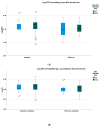Oral Myco- and Bacteriobiota and Yeast Infections in Mechanically Ventilated COVID-19 Patients
- PMID: 37374944
- PMCID: PMC10301763
- DOI: 10.3390/microorganisms11061442
Oral Myco- and Bacteriobiota and Yeast Infections in Mechanically Ventilated COVID-19 Patients
Abstract
Critically ill COVID-19 patients requiring mechanical ventilation in the intensive care unit are at risk of developing invasive candidiasis. In this study we aimed to (1) characterize oral cultivable mycobiota of mechanically ventilated adult COVID-19 patients in an ICU setting by sampling four distinct oral niches in two fixed time points with regards to oral health status, (2) investigate Candida spp. infections in this population, and (3) compare oral mycobiota with selected bacteriobiota strains during the observation in the ICU. We recruited 56 adult COVID-19 patients who qualified for mechanical ventilation. Patients received either standard or extended oral care procedures with tooth brushing. Oral samples were taken first within 36 h and after 7 days of intubation. Yeast-like fungi were identified by MALDI/TOF mass spectrometry. Yeast infection cases were retrospectively analyzed. Candida spp. in oral sampling was identified in 80.4% and 75.7%, C. albicans in 57.1% and 61.1%, and non-albicans Candida species in 48.2% and 47.2% patients at baseline and follow-up, respectively. There were no differences in the overall CFU counts of Candida spp. species and individual Candida species in oral samples, both at baseline and follow-up. At baseline, a higher prevalence of Candida spp. was associated with a higher identification rate of Lactobacillus spp. (64.4% vs. 27.3%, p = 0.041). At follow-up, there was a borderline lower prevalence of Candida spp. in patients with Lactobacillus spp. identified (57.1% vs. 87.0%, p = 0.057). The incidence rate of candidiasis was 5.4% and the incidence density was 3.1/1000 pds. In conclusion, non-albicans Candida species in oral samples were identified in nearly half of patients. Oral health was moderately impaired. A high incidence of yeast infections, including invasive cases, in patients hospitalized in the ICU due to COVID-19 and requiring mechanical ventilation was noted. Severe COVID-19 and disease-specific interventions within the ICU possibly played a major role promoting Candida spp. infections.
Keywords: Candida; candidemia; candidiasis; fungal community; fungal microbiota; invasive candidiasis; mycoses; yeast infections; yeasts.
Conflict of interest statement
The authors declare no conflict of interest.
Figures





References
-
- Szymańska J., Wójtowicz A., Malm A. Assessment of Candida spp. frequency in the oral cavity ontocenosis of healthy individuals in different age groups. J. Pre.-Clin. Clin. Res. 2016;10:91–94. doi: 10.5604/18982395.1227563. - DOI
Grants and funding
LinkOut - more resources
Full Text Sources
Miscellaneous

